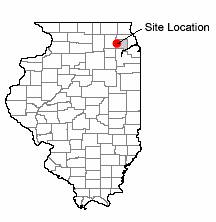|
|

This site is located at 603 Fenton Lane, West Chicago, Dupage County, Illinois
Former W.R. Grace & Company Site
West Chicago, Illinois
Site Background
From 1974 to the early 1990's, the former W.R. Grace & Company facility at 603 Fenton Lane in West Chicago, Illinois, processed vermiculite mined in Libby, Montana. This vermiculite was contaminated with asbestos.
The facility exfoliated ("popped" or expanded) vermiculite, which could then be used to manufacture other products. The West Chicago plant processed over 273,000 tons of vermiculite.
W.R. Grace closed the facility in 1996 and sold the 6.4-acre site to Royal Corinthian in 1998. Royal Corinthian manufactures marble columns and rails inside the former processing building.
Land use immediately surrounding the site is primarily commercial and light industrial. Currently, the nearest residential area is approximately one-half mile east of the site. According to the U.S. Census, over 3,000 people were living within one mile of the site in 1990, which is around the time the plant stopped exfoliating Libby vermiculite.
The ground around the building is paved, but much of the rest of site is undeveloped. Recent EPA sampling results indicated a trace amount of residual Libby asbestos in the soil. Samples collected by W.R. Grace in 1996 showed that Libby asbestos levels in the air inside the building were well below levels that would be a health concern. Some information about the air sample results is missing and should be obtained, if possible, to confirm this conclusion. No vermiculite or vermiculite waste stockpiles are present at the site.
Conclusions and Recommendations
Former Workers
- Conclusion: Former workers at the W.R. Grace plant were exposed to hazardous levels of asbestos. People who lived with former workers were probably also exposed to hazardous levels from fibers carried home on workers' hair and clothing.
- Recommendation: Identify former W.R. Grace workers and their household contacts (people who lived with them) to evaluate potential health effects.
Current Workers
- Conclusion: Under current conditions, and assuming only occasional contact with soil that contains Libby asbestos, onsite exposure of workers to contaminated soils does not appear to pose a public health hazard. Based on historical air sample results, the facility appeared to have been cleaned, so the levels of asbestos in air do not appear to pose a public health hazard.
- Recommendation: Provide independent confirmation that current workers inside the building are not being exposed to hazardous levels of Libby asbestos.
Past Community
- Conclusion: Currently not enough data are available to determine whether people who lived near the plant were exposed to hazardous levels of Libby asbestos.
- Recommendation: Review new information that becomes available to determine appropriate actions to protect public health.
Present Community
- Conclusion: Community exposure to Libby asbestos from plant emissions or from onsite asbestos-contaminated materials poses no public health hazard. Not enough information is available, however, to determine whether individuals are being exposed to Libby asbestos through direct contact with waste that may have been used in the community. In other communities, waste vermiculite has been used for a variety of purposes, such as fill, driveway surfacing, or soil amendments.
- Recommendation: Review new information that becomes available to determine appropriate actions to protect public health.
Consumer Products
- ATSDR did not evaluate products that contain Libby vermiculite, such as vermiculite attic insulation, as part of this project. Information concerning vermiculite consumer products is available on ATSDR's Web site at www.atsdr.cdc.gov/NEWS/vermiculite051603.html and on EPA's Web site at www.epa.gov/asbestos/
 .
.
Where can I find more information?
The public health consultation for the West Chicago site is available on the Internet.
The document also may be reviewed in person at the following locations:
West Chicago Public Library
118 W. Washington St., (630) 231-1552
Winfield Public Library
OS 291 Winfield Rd., (630) 653-7599
Public input and questions are encouraged. ATSDR responses will be provided in a separate document available to the public and not as an additional release of this site-specific health consultation. Comments on the health consultation must be submitted in writing by October 31, 2003. Mail comments to:
Chief, Program Evaluation, Records and Information Services Branch, ATSDR
1600 Clifton Rd., NE (MS E-60)
Atlanta, GA 30333
The names of those who submit comments will not be printed in a public document. They are, however, subject to release through requests made under the U.S. Freedom of Information Act.
For more information, please call the Ilinois Department of Public Health at 217-782-5830 and ask to speak with Environmental Health Specialists Jennifer Davis or Ken Runkle. Callers should refer to the former W.R. Grace West Chicago site.
The Agency for Toxic Substances and Disease Registry (ATSDR) is a federal public health agency of the U.S. Department of Health and Human Services. ATSDR was created by the Comprehensive Environmental Response, Compensation, and Liability Act of 1980 (CERCLA, also called the Superfund law). This law established ATSDR as the federal health agency to deal with environmental health issues at hazardous waste sites. The agency's mission is to prevent exposure and adverse health effects from a variety of hazardous substance sources.
This page last updated on December 08, 2008


